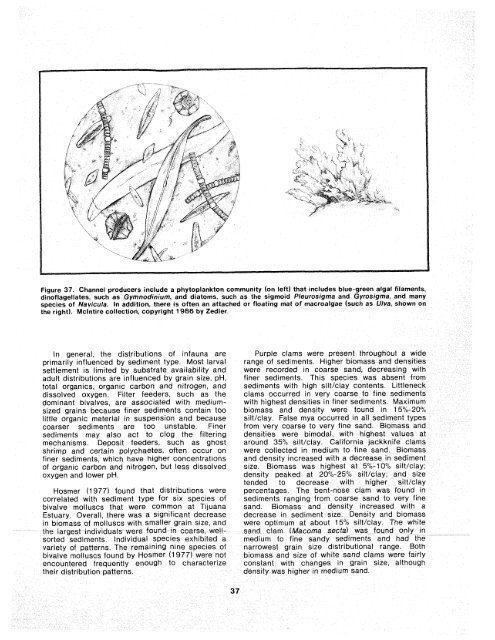The Ecology of Tijuana Estuary, California: An Estuarine Profile
The Ecology of Tijuana Estuary, California: An Estuarine Profile
The Ecology of Tijuana Estuary, California: An Estuarine Profile
You also want an ePaper? Increase the reach of your titles
YUMPU automatically turns print PDFs into web optimized ePapers that Google loves.
Figure 37. Channel producers include a phytoplankton community (on left) that includes blue-green algal filaments,<br />
din<strong>of</strong>lagellates, such as Gymnodinium, and diatoms, such as the sigmoid Pleurosigma and Gyrosigma, and many<br />
species <strong>of</strong> Navicula. In addition, there is <strong>of</strong>ten an attached or floating mat <strong>of</strong> macroalgae (such as Ulva, shown on<br />
the right). Mclntire collection, copyright 1986 by Zedler.<br />
In general, the distributions <strong>of</strong> infauna are Purple clams were present ihroughout a wide<br />
primarily influenced by sediment type. Most larval range <strong>of</strong> sediments. Higher biomass and densities<br />
settlement is limited by substrate availability and were recorded in coarse sand, decreasing with<br />
adult distr~butions are influenced by grain size, pH, finer sediments. This species was absent from<br />
total organics, organic carbon and nitrogen, and sediments with high silt/clay contents. Littleneck<br />
dissolved oxygen. Filter feeders, such as the clams occurred in very coarse to fine sediments<br />
dominant bivalves, are associated with medium- with highest densities in finer sediments. Maximum<br />
sized grains because finer sediments contain too biomass and density were found in 15%-2O0I0<br />
little organic material in suspension and because silt/clay. False mya occurred in all sediment types<br />
coarser sediments are too unstable. Finer from very coarse to very fine sand. Biomass and<br />
sediments may also act to clog the filtering densities were bimodal, with highest values at<br />
mechanisms. Deposit feeders, such as ghost around 35% silt/clay. <strong>California</strong> jackknife clams<br />
shrimp and certain polychaetes, <strong>of</strong>ten occur on were collected in medium to fine sand. Biomass<br />
finer sediments, which have higher concentrations and density increased with a decrease in sediment<br />
<strong>of</strong> organic carbon and nitrogen, but less dissolved size. Biomass was highest at 5%-10% silt/clay;<br />
oxygen and lower pH.<br />
density peaked at 20°/o-250~~ silt/cfay; and size<br />
tended to decrease with higher silt/clay<br />
Hosmer (1977) found that distributions were percentages. <strong>The</strong> bent-nose clam was found in<br />
correlated with sediment type for six species <strong>of</strong> sediments ranging from coarse sand to very fine<br />
bivalve molluscs that were common at <strong>Tijuana</strong> sand. Biomass and density increased with a<br />
<strong>Estuary</strong>. Overall, there was a significant decrease decrease in sediment size. Density and biomass<br />
'<br />
biomass <strong>of</strong> molluscs with smaller grain size, and were optimum af about 15% silt/cfay. <strong>The</strong> white<br />
e largest individuats were foind in coarse, well- sand clam (Macoma secta) was found only in<br />
rted sediments. Individual species exhibited a medium to fine sandy sediments and had the<br />
variety <strong>of</strong> patterns. <strong>The</strong> remaining nine species <strong>of</strong> narrowest grain size distributional range. Both<br />
bivalve molluscs found by Hosmer (1977) were not biomass and size <strong>of</strong> white sand clams were fairly<br />
encountered frequently enough to characterize constant with changes in grain size, although<br />
their distribution patterns.<br />
densrty was higher in medium sand.<br />
37

















